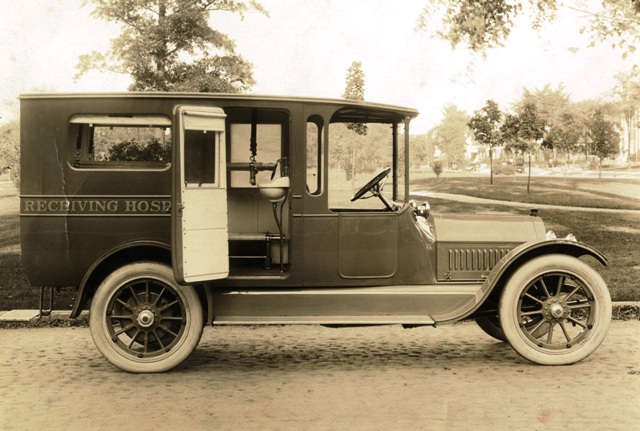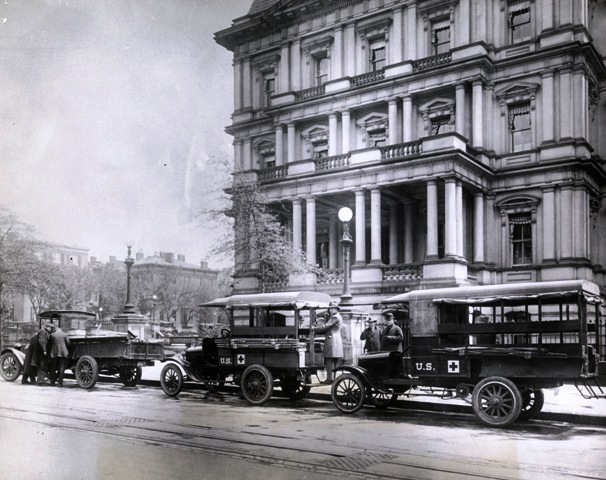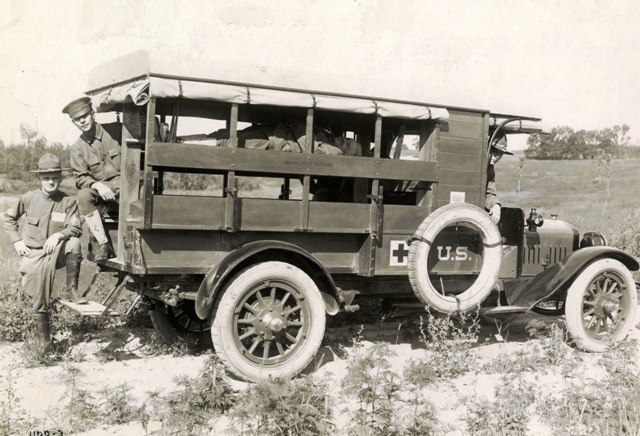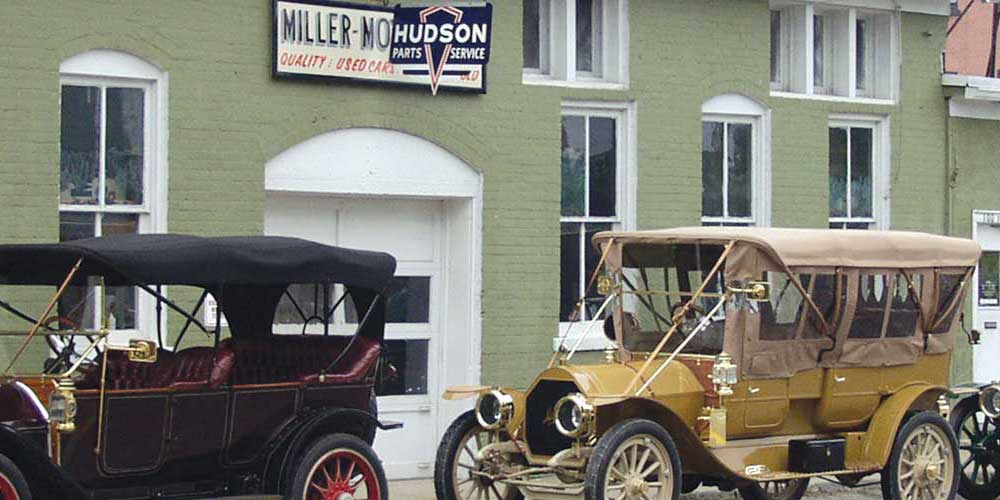By: Robert Tate, Automotive Historian/Researcher
Images: Courtesy of the National Automotive History Collection
Posted: 07.29.2015
Looking back on America’s history of the ambulance and the great service it has provided for our communities, you have to go all the way back to the very beginning. This week’s story highlights how medical ambulance services began in this country and how they assisted with war time efforts.
 Cadillac Ambulance for Recieving HospitalThe history of ambulance transport services actually started in the year 1703. This was the first example of a full time hospital-based transport medical service. Later, in 1867, the innovative and discreet ambulance devised by London's Hospital Carriage committee was developed. It became the first civilian vehicle in Europe to meet the criteria for a completely modern ambulance service. It had a specialty designed affiliation with a hospital and was provisioned for en route medical care en the patients that needed it.
Cadillac Ambulance for Recieving HospitalThe history of ambulance transport services actually started in the year 1703. This was the first example of a full time hospital-based transport medical service. Later, in 1867, the innovative and discreet ambulance devised by London's Hospital Carriage committee was developed. It became the first civilian vehicle in Europe to meet the criteria for a completely modern ambulance service. It had a specialty designed affiliation with a hospital and was provisioned for en route medical care en the patients that needed it.
During the beginning of the Civil War, no unified ambulance corps existed in either the Union or Confederate armies and as a result many men died during the war. As the ambulance services would continue, the two-wheeled ambulance service would provide communities with transportation. However, those lucky enough to survive the trip had to deal with a great deal of jolting and rocking which was very uncomfortable for riders.
 Ambulance in 1900s Washington DCDuring World War I, General Motors turned its facilities and experience toward the production of war materials. Between 1917 and 1919 GM offered a large percentage of their truck production for the war time effort. It was a great satisfaction to the General Motors Truck Company that the medical department of the United States Army found the GMC ¾-ton chassis to meet all the requirements and standards for the work needed to be accomplished. After the declaration of war, many individuals and societies desired to show their patriotism by presenting their favorite regiment with one or more ambulances. While the government encouraged this patriotism and the desire to aid the work of equipping the army, it required all ambulances to comply with the government regulations and standard specifications, even to the color of the paint (green).
Ambulance in 1900s Washington DCDuring World War I, General Motors turned its facilities and experience toward the production of war materials. Between 1917 and 1919 GM offered a large percentage of their truck production for the war time effort. It was a great satisfaction to the General Motors Truck Company that the medical department of the United States Army found the GMC ¾-ton chassis to meet all the requirements and standards for the work needed to be accomplished. After the declaration of war, many individuals and societies desired to show their patriotism by presenting their favorite regiment with one or more ambulances. While the government encouraged this patriotism and the desire to aid the work of equipping the army, it required all ambulances to comply with the government regulations and standard specifications, even to the color of the paint (green).
Normal capacity for ambulance models was four lying down patients or eight patients in a sitting position with room in either case for one attendant on a seat with the driver. One of the first female ambulance surgeons who had a long tradition of providing great service was Dr. Emily Dunning. She would later become a strong voice on issues affecting women in medicine. GMC ambulances were also used in the British army service along with Italy, France, Mesopotamia and other great parts of the world. During World War I, the facilities of the General Motors truck company plant in Pontiac Michigan manufactured the building of these great ambulances for the United States Army.
 Ambulance During World War IThe photograph that is included in this story shows the American Red Cross first aid ambulances used in World War I parked in front of the state department, Washington D.C. As World War I began, the United States made every provision for the care of its sick and wounded. One very important feature of the preparation was to furnish an ample supply of motor driven ambulances fully equipped and manned. After receiving first aid, many of the wounded soldiers were quickly transported to the field of hospitals and given care from the nurses and surgeons.
Ambulance During World War IThe photograph that is included in this story shows the American Red Cross first aid ambulances used in World War I parked in front of the state department, Washington D.C. As World War I began, the United States made every provision for the care of its sick and wounded. One very important feature of the preparation was to furnish an ample supply of motor driven ambulances fully equipped and manned. After receiving first aid, many of the wounded soldiers were quickly transported to the field of hospitals and given care from the nurses and surgeons.
 GMC Ambulance BrochureCadillac ambulances were also used as part of the war effort. In the summer of 1917, several American automobiles were tested in a 2,000 mile run. The final results showed the Cadillac to be the best among all the competitors. Cadillac ambulances were not just used for the war time efforts but for many other hospitals as well along with Buick and other ambulance models. For example, Receiving Hospital in Detroit, Michigan, which is one of the oldest hospitals in Detroit (1915), also offered medical transport services for its patients.
GMC Ambulance BrochureCadillac ambulances were also used as part of the war effort. In the summer of 1917, several American automobiles were tested in a 2,000 mile run. The final results showed the Cadillac to be the best among all the competitors. Cadillac ambulances were not just used for the war time efforts but for many other hospitals as well along with Buick and other ambulance models. For example, Receiving Hospital in Detroit, Michigan, which is one of the oldest hospitals in Detroit (1915), also offered medical transport services for its patients.
On an important note, I don't want to leave the Red Cross out of this story of the history of ambulance services. At the beginning of the war, the American Red Cross was a small organization that was still in the process of developing its identity and great programs for people in need. By the time the war had ended in November 1918, the Red Cross had become a major national humanitarian organization which is still around and helping people today.
A special thanks to Robert Tate, Automotive Historian and Researcher, for donating the story to the MotorCities Story of the Week program. Photographs are courtesy of the National Automotive History Collection. (Bibliography: Bell Corbett Ryan. “A History The Ambulance” Mc Farland & company, Inc Publishers 2009. Automobile Quarterly Publications. “GM the First 75 Years of Transportation Products” 1983.)
For further information on photos please visit http://www.detroitpubliclibrary.org/ or email This email address is being protected from spambots. You need JavaScript enabled to view it.. Please do not republish the story and/or photographs without permission of MotorCities National Heritage Area.
If you would like to contribute an article for the MotorCities newsletter, email This email address is being protected from spambots. You need JavaScript enabled to view it. or call 313-259-3425.



